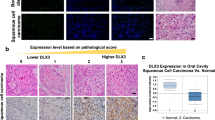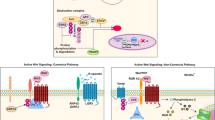Abstract
The zinc-finger-type transcriptional factor KLF4 is expressed in a variety of tissues including skin. KLF4 can function as either a tumor suppressor or an oncogene, depending on the type of tissue in which it is expressed, by modulating the expression of various factors. To understand the role of KLF4 in human skin cancer and also to evaluate the expression of cyclin D1, p53, and p21Waf1/Cip1 in relation to the expression of KLF4, we evaluated the pattern of KLF4 expression during UVB-induced skin tumor development in SKH-1 hairless mice and in human skin cancer. We also determined whether there are correlations between the expression of KLF4, cyclin D1, p53, and p21 and non-melanoma skin tumors. KLF4 expression was found in the basal layer of non-irradiated control murine skin. Chronic UVB irradiation caused a progressive decrease in KLF4 expression, which was substantially decreased in UVB-induced murine skin tumors. In human precancerous lesions, KLF4 expression was maintained in 64.3% of Bowen’s disease samples and 90.0% of AK samples. In contrast, KLF4 expression was significantly reduced in human cancer lesions (p = 0.004). A positive correlation was found between the expression of KLF4 and p21Waf1/Cip1 in AK, whereas there was a negative correlation between the expression of cyclin D1 and p21Waf1/Cip1 in Bowen’s disease. Thus, our results suggest that KLF4 may function as a tumor suppressor in the skin and that the deregulated expression of KLF4 in the context of p21Waf1/Cip1 and cyclin D1 expression may be involved in skin tumorigenesis.





Similar content being viewed by others
References
Athar M, Back JH, Tang X et al (2007) Resveratrol: a review of preclinical studies for human cancer prevention. Toxicol Appl Pharmacol 224(3):274–283
Auepemkiate S, Boonyaphiphat P, Thongsuksai P (2002) p53 expression related to the aggressive infiltrative histopathological feature of basal cell carcinoma. Histopathology 40:568–573
Baur JA, Sinclair DA (2006) Therapeutic potential of resveratrol: the in vivo evidence. Nat Rev Drug Discov 5(6):493–506
Bishop JM (1991) Molecular themes in oncogenesis. Cell 64:235–248
Brash DE, Heffernan T, Ngheim P (2008) Carcinogenesis: ultraviolet radiation. In: Wolff K (ed) Fizpatrick’s dermatology in general medicine, 7th edn. McGraw-Hill, New York, pp 999–1006
Chen YJ, Wu CY, Chang CC, Ma CJ, Li MC, Chen CM (2008) Nuclear Krüppel-like factor 4 expression is associated with human skin squamous cell carcinoma progression and metastasis. Cancer Biol Ther 7:777–782
Dang DT, Pevsner J, Yang VW (2000) The biology of the mammalian Kruppel-like family of transcription factors. Int J Biochem Cell Biol 32:1103–1121
Dlugosz AA, Yuspa SH (2008) Carcinogenesis: chemical. In: Wolff K (ed) Fizpatrick’s dermatology in general medicine, 7th edn. McGraw-Hill, New York, pp 986–995
El-Deiry WS, Tokino T, Velculescu VE, Levy DB, Parsons R, Trent JM, Lin D, Mercer WE, Kinzler KW, Vogelstein B (1993) WAF1, a potential mediator of p53 tumor suppression. Cell 75:817–825
Evans PM, Liu C (2008) Roles of kruppel-like factor 4 in normal homeostasis, cancer, stem cells. Acta Biochim Biophys Sin 40:554–564
Foster KW, Frost AR, McKie-Bell P, Lin CY, Engler JA, Grizzle WE, Ruppert JM (2000) Increase of GKLF messenger RNA and protein expression during progression of breast cancer. Cancer Res 60:6488–6495
Foster KW, Liu Z, Nail CD, Li X, Fitzgerald TJ, Bailey SK, Frost AR, Louro ID, Townes TM, Paterson AJ, Kudlow JE, Lobo-Ruppert SM, Ruppert JM (2005) Induction of KLF4 in basal keratinocytes blocks the proliferation–differentiation switch and initiates squamous epithelial dysplasia. Oncogene 24:1491–1500
Huang CC, Liu Z, Li X, Bailey SK, Nail CD, Foster KW, Frost AR, Ruppert JM, Lobo-Ruppert SM (2005) KLF4 and PCNA identify stages of tumor initiation in a conditional model of cutaneous squamous epithelial neoplasia. Cancer Biol Ther 4:1401–1408
Jaubert J, Cheng J, Segre JA (2003) Ectopic expression of kruppel like factor 4 (Klf4) accelerates formation of the epidermal permeability barrier. Development 130:2767–2777
Kaczynski J, Cook T, Urrutia R (2003) Sp1-and Kruppel-like transcription factors. Genome Biol 4:206
Kan CE, Patton JT, Stark GR, Jackson MW (2007) p53-mediated growth suppression in response to nutlin-3 in cyclin D1-transformed cells occurs independently of p21. Cancer Res 67:9862–9868
Katz JP, Perreault N, Goldstein BG, Actman L, McNally SR, Silberg DG, Furth EE, Kaestner KH (2005) Loss of Klf4 in mice causes altered proliferation and differentiation and precancerous changes in the adult stomach. Gastroenterology 28:935–945
Leiter U, Garbe C (2008) Epidemiology of melanoma and nonmelanoma skin cancer—the role of sunlight. Adv Exp Med Biol 624:89–103
Levine AJ, Momand J, Finlay CA (1991) The p53 tumor suppressor gene. Nature 351:453–456
Liang SB, Furihata M, Takeuchi T, Iwata J, Chen BK, Sonobe H, Ohtsuki Y (2000) Overexpression of cyclin D1 in nonmelanocytic skin cancer. Virchow Arch 436:370–376
Michieli P, Chedid M, Lin D, Pierce JH, Mercer WE, Givol D (1994) Induction of WAF1/CIP1 by a p53-independent pathway. Cancer Res 54:3391–3395
Murias M, Jager W, Handler N et al (2005) Antioxidant, prooxidant and cytotoxic activity of hydroxylated resveratrol analogues: structure–activity relationship. Biochem Pharmacol 69(6):903–912
Pandya AY, Talley LI, Frost AR, Fitzgerald TJ, Trivedi V, Chakravarthy M, Chhieng DC, Grizzle WE, Engler JA, Krontiras H, Bland KI, LoBuglio AF, Lobo-Ruppert SM, Ruppert JM (2004) Nuclear localization of KLF4 is associated with an aggressive phenotype in early-stage breast cancer. Clin Cancer Res 10:2709–2719
Rehman I, Takata M, Wu YY, Rees JL (1996) Genetic change in actinic keratosis. Oncogene 12:2483–2490
Rowland BD, Bernards R, Peeper DS (2005) The KLF4 tumour suppressor is a transcriptional repressor of p53 that acts as a context-dependent oncogene. Nat Cell Biol 7:1074–1082
Rowland BD, Peeper DS (2006) KLF4, p21 and context-dependent opposing forces in cancer. Nat Rev Cancer 6:11–23
Segre JA, Bauer C, Fuchs E (1999) Klf4 is a transcription factor required for establishing the barrier function of the skin. Nat Genet 22:356–360
Shea CR, McNutt NS, Volkenandt M, Lugo J, Prioleau PG, Albino AP (1992) Overexpression of p53 protein in basal cell carcinoma of the skin. Am J Pathol 141:25–29
Suske G, Brudford E, Philipsen S (2005) Mammalian SP/KLF transcription factors: bring in the family. Genomics 85:551–556
Wei D, Kanai M, Huang S, Xie K (2006) Emerging role of KLF4 in human gastrointestinal cancer. Carcinogenesis 27:23–31
Xu J, Lü B, Xu F, Gu H, Fang Y, Huang Q, Lai M (2008) Dynamic down-regulation of Krüppel-like factor 4 in colorectal adenoma-carcinoma sequence. J Cancer Res Clin Oncol 134:891–898
Yang Y, Goldstein BG, Chao HH, Katz JP (2005) KLF4 and KLF5 regulate proliferation, apoptosis and invasion in esophageal cancer cells. Cancer Biol Ther 4:1216–1221
Yet SF, McA’Nulty MM, Folta SC, Yen HW, Yoshizumi M, Hsieh CM, Layne MD, Chin MT, Wang H, Perrella MA, Jain MK, Lee ME (1998) Human EZF, a Kruppel-like zinc finger protein, is expressed in vascular endothelial cells and contains transcriptional activation and repression domains. J Biol Chem 273:1026–1031
Acknowledgments
The authors have no funding sources for this work.
Conflict of interest
The authors have no conflict of interest to disclose.
Author information
Authors and Affiliations
Corresponding author
Rights and permissions
About this article
Cite this article
Choi, W.J., Youn, S.H., Back, J.H. et al. The role of KLF4 in UVB-induced murine skin tumor development and its correlation with cyclin D1, p53, and p21Waf1/Cip1 in epithelial tumors of the human skin. Arch Dermatol Res 303, 191–200 (2011). https://doi.org/10.1007/s00403-010-1101-0
Received:
Revised:
Accepted:
Published:
Issue Date:
DOI: https://doi.org/10.1007/s00403-010-1101-0




